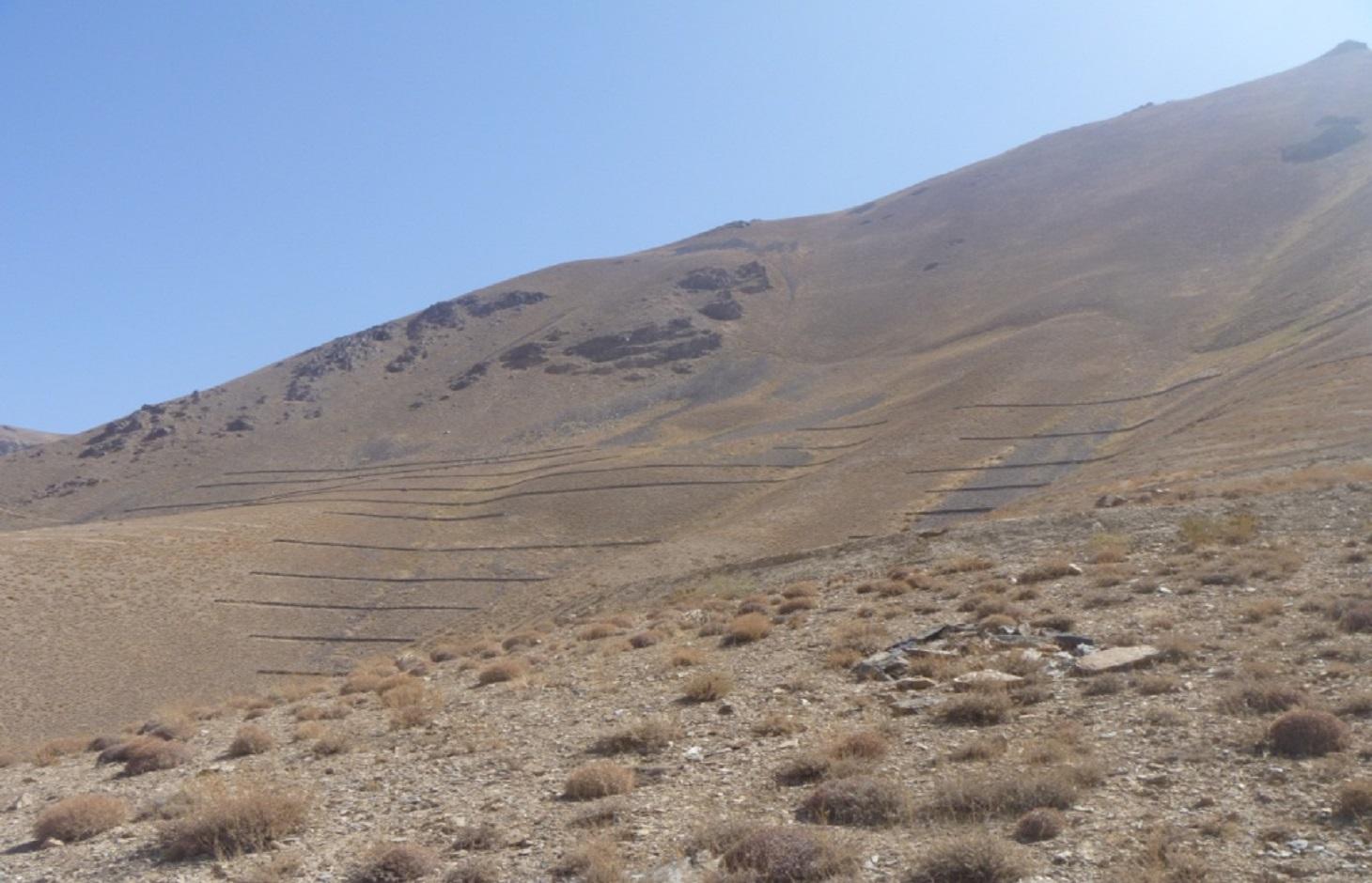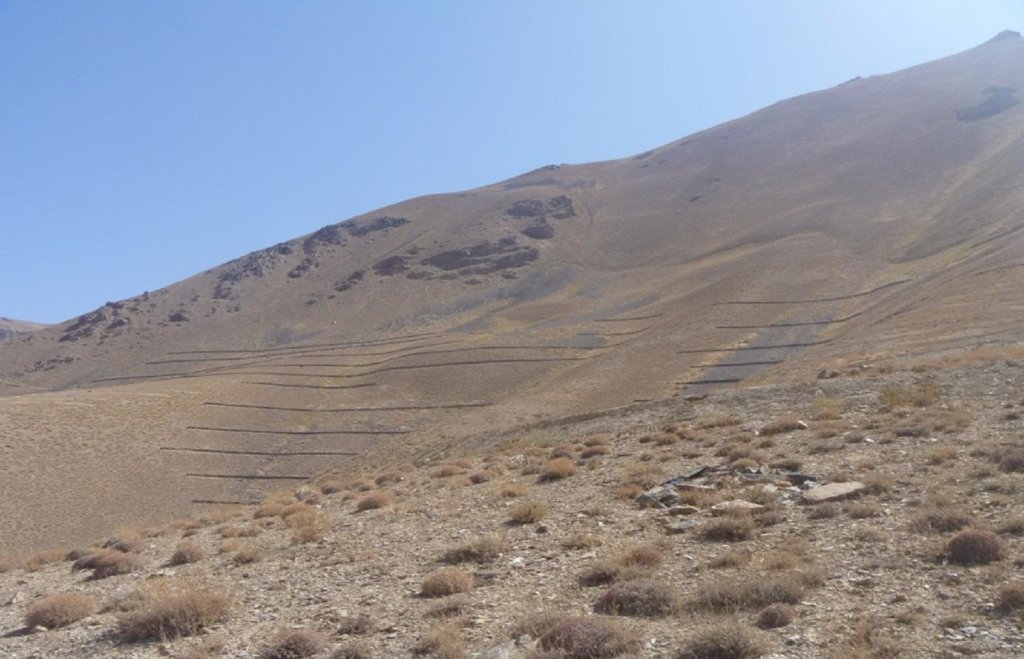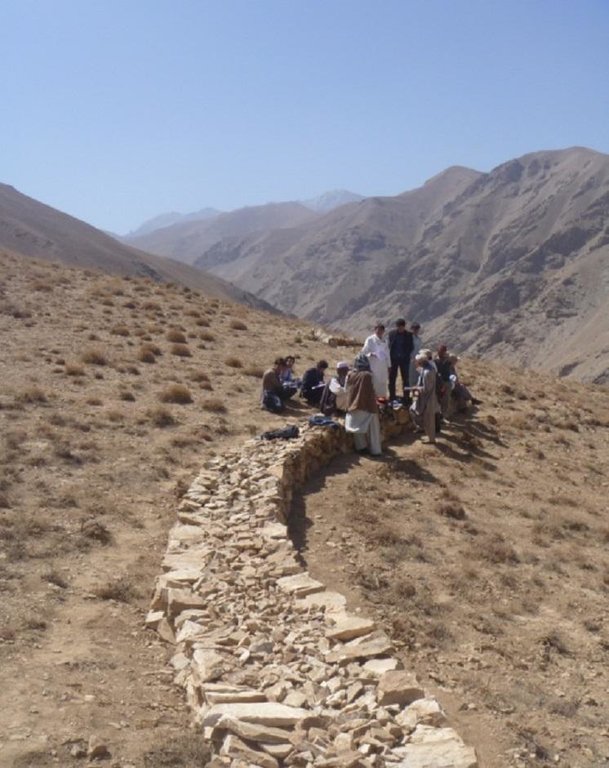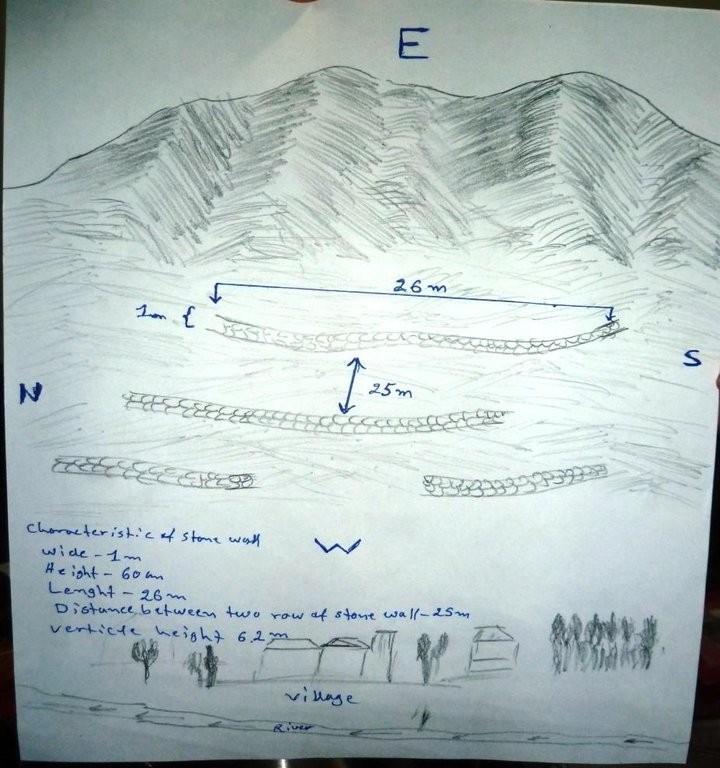Stone wall [阿富汗]
- 创建:
- 更新:
- 编制者: Aqila Haidery
- 编辑者: –
- 审查者: David Streiff
Diwar Sangi (Dari)
technologies_1723 - 阿富汗
查看章节
全部展开 全部收起1. 一般信息
1.2 参与该技术评估和文件编制的资源人员和机构的联系方式
SLM专业人员:
SLM专业人员:
SLM专业人员:
Burger Sieger
SLM专业人员:
Saadat Alemi
SLM专业人员:
Zainullah Hazem
SLM专业人员:
Hussein Muhammadi
SLM专业人员:
Zekrullah Ahmedi
SLM专业人员:
Reza Ahmedi
SLM专业人员:
Ershad Mustafa
mustafa.ershad@crs.org
Catholic Relief Service
阿富汗
有助于对技术进行记录/评估的机构名称(如相关)
HELVETAS (Swiss Intercooperation)有助于对技术进行记录/评估的机构名称(如相关)
Catholic Relief Services/East Africa (Catholic Relief Services/East Africa) - 肯尼亚1.3 关于使用通过WOCAT记录的数据的条件
(现场)数据是什么时候汇编的?:
14/09/2011
编制者和关键资源人员接受有关使用通过WOCAT记录数据的条件。:
是
1.5 请参阅有关SLM方法的问卷
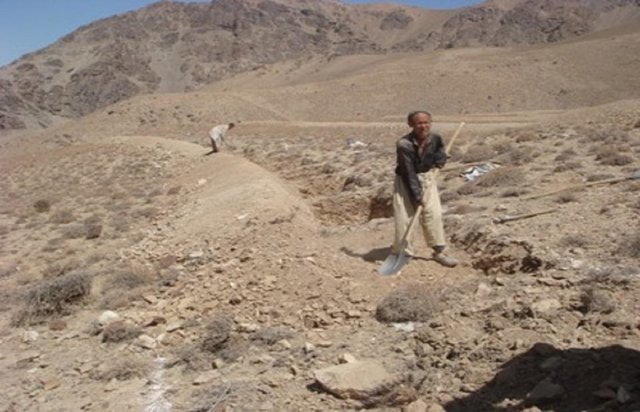
Community-Based Watershed Management [阿富汗]
Sustainable implementation of watershed management through appropriate SLM technologies, formation of organizational structures and capacity building of stakeholders
- 编制者: Aqila Haidery
2. SLM技术的说明
2.1 技术简介
技术定义:
Contour stone walls constructed on moderate to steep slopes to retain water and sediments and trap snow.
2.2 技术的详细说明
说明:
The Stone wall technology is documented by Sustainable Land Management Project/HELVETAS Swiss Intercooperation with financial support of Swiss Agency for Development and Cooperation(SDC) and close support and cooperation of the Catholic Relief Service (CRS). The technology was applied in community land in Sar e Ahangaran (Siakhar Toghai) watershed which drains into the main Bamyan valley forming part of the Kunduz watershed of the Amu Darya river basin. The project was initiated by CRS (Catholic Relief Services) in October 2009 and the participating families were involved in each stage of intervention, including surveys, design, and implementation and monitoring.
Purpose of the Technology: The main function of stone wall is to trap snow and control run-off. Through construction work, many families received income through cash for work. About 21,519 USD were spent on the technology, with 90% contribution from CRS and 10% from the participating community. The cost for implementing Stone Wall technology was about 2,390 USD/ha.
Establishment / maintenance activities and inputs: The technology was applied in extensive grazing land. The stone wall technology is not new to the farmers of Sar e Ahangaran (Siakhar Toghai) as they have applied it in their private croplands as well. CRS built on this traditional technology and improved it by applying it along contour lines demarcated with A-frame and establishing it a more technically sound manner. The technology is effective in reducing snow avalanches, surface run-off, sediments, and downstream flooding leading to more crop production and less destruction of property and crops. It is tolerant to increasing or decreasing temperature and droughts. If constructed properly along the contour, the technology is not impacted by heavy rainfall or severe flash floods.
Natural / human environment: The technology was applied on hill and mountain slopes at 3000-3500 m elevation. The average annual rainfall in the area is 250-500 mm. The longest growing period is 6 months, i.e. from April to September. Due to its proximity to the Koh-i-Baba mountains, the area experiences long, severe winters of around 6 months (Mid-October to mid-April).
The participating families are poor; 10-50 % of their income is from off-farm activities, e.g. labour, migration. The villagers have moderate access to health, education, technical assistance, drinking water and sanitation facilities. Accessibility to employment, markets, energy, good roads and financial services is poor. The production system is subsistence-oriented and non-subsidized.
The effectiveness of stone wall technology was strengthened through other SLM measures, including contour trench bund, gully plugs, shrub cutting and grazing control, planting trees below the walls, and re-sowing with improved fodder species.
2.3 技术照片
2.5 已应用该技术的、本评估所涵盖的国家/地区/地点
国家:
阿富汗
区域/州/省:
Sar-e-Ahangaran, Bamyan, Afghanistan
2.6 实施日期
如果不知道确切的年份,请说明大概的日期:
- 10-50年前
2.7 技术介绍
详细说明该技术是如何引入的:
- 在实验/研究期间
3. SLM技术的分类
3.1 该技术的主要目的
- 减少、预防、恢复土地退化
- 降低灾害风险
3.2 应用该技术的当前土地利用类型

牧场
粗放式放牧场:
- 游牧
集约放牧/饲料生产:
- 收割和携带/零放牧
注释:
Major land use problems (compiler’s opinion): Degradation of slopes due to biotic pressures such as overgrazing, extraction of bushes for fuel and cultivation leading to snow avalanche, flash floods and decrease in spring water quantity. Lack of soil and water conservation measures on slopes contribute to low production from agriculture and pasture lands.
Future (final) land use (after implementation of SLM Technology): Grazing land: Gi: Intensive grazing/ fodder production
如果由于技术的实施而导致土地用途发生变化,则在技术实施前说明土地利的用途。:
Grazing land: Ge: Extensive grazing land
3.3 有关土地利用的更多信息
该技术所应用土地的供水:
- 混合雨水灌溉
具体说明:
Longest growing period in days: 180; Longest growing period from month to month: April to September
牲畜密度(如相关):
25-50 LU /km2
3.4 该技术所属的SLM组
- 横坡措施
3.5 技术传播
具体说明该技术的分布:
- 适用于特定场所/集中在较小区域
注释:
Total area covered by the SLM Technology is 0.09 km2.
3.6 包含该技术的可持续土地管理措施

结构措施
- S6:墙、障碍物、栅栏、围墙
3.7 该技术强调的主要土地退化类型

生物性退化
- Bc:植被覆盖的减少
注释:
Main causes of degradation: over-exploitation of vegetation for domestic use, overgrazing, Contamination of water due to floods
3.8 防止、减少或恢复土地退化
具体数量名该技术与土地退化有关的目标:
- 减少土地退化
4. 技术规范、实施活动、投入和成本
4.1 该技术的技术图纸
4.2 技术规范/技术图纸说明
The hand drawing shows the dimensions of the technology, spacing, area’s borders and as well as the downstream area.
Stone wall dimensions are as follows:
length: 26 m; width: 1m; height: 60 cm; foundation: 30cm in depth.
Technical knowledge required for field staff / advisors: low
Technical knowledge required for land users: moderate
Main technical functions: control of dispersed runoff: impede / retard, reduction of slope length, Reduction of snow avalanches
Secondary technical functions: Improvement of ground cover due to less soil erosion
Wall/ barrier
Spacing between structures (m): 25
Height of bunds/banks/others (m): 0.6
Width of bunds/banks/others (m): 26
Length of bunds/banks/others (m): 1
Construction material (stone): Dry stone masonry
4.3 有关投入和成本计算的一般信息
具体说明成本计算所用货币:
- 美元
注明雇用劳工的每日平均工资成本:
6
4.4 技术建立活动
| 活动 | 措施类型 | 时间 | |
|---|---|---|---|
| 1. | Excavation of the foundation | 结构性的 | |
| 2. | Construction of the stone wall | 结构性的 |
4.5 技术建立所需要的费用和投入
| 对投入进行具体说明 | 单位 | 数量 | 单位成本 | 每项投入的总成本 | 土地使用者承担的成本% | |
|---|---|---|---|---|---|---|
| 劳动力 | Excavation of the foundation | persons/day/ha | 13.75 | 6.0 | 82.5 | 10.0 |
| 劳动力 | Construction of the stone wall (skilled labour) | persons/day/ha | 39.73 | 12.0 | 476.76 | 10.0 |
| 劳动力 | Construction of the stone wall (unskilled labour) | persons/day/ha | 132.43 | 6.0 | 794.58 | 10.0 |
| 施工材料 | Stone | m3 | 132.43 | 7.82 | 1035.6 | |
| 技术建立所需总成本 | 2389.44 | |||||
注释:
Duration of establishment phase: 10 month(s)
4.6 维护/经常性活动
| 活动 | 措施类型 | 时间/频率 | |
|---|---|---|---|
| 1. | No information on maintenance available. | 结构性的 |
4.8 影响成本的最重要因素
描述影响成本的最决定性因素:
Duration of the establishment phase in 0.9 square kilometer in 10 months.
5. 自然和人文环境
5.1 气候
年降雨量
- < 250毫米
- 251-500毫米
- 501-750毫米
- 751-1,000毫米
- 1,001-1,500毫米
- 1,501-2,000毫米
- 2,001-3,000毫米
- 3,001-4,000毫米
- > 4,000毫米
有关降雨的规范/注释:
Bamyan has a very harsh 6 months winter with a heavy snow fall. Most of its villages face with scarcity of water during the summer
农业气候带
- 半干旱
Thermal climate class: temperate
5.2 地形
平均坡度:
- 水平(0-2%)
- 缓降(3-5%)
- 平缓(6-10%)
- 滚坡(11-15%)
- 崎岖(16-30%)
- 陡峭(31-60%)
- 非常陡峭(>60%)
地形:
- 高原/平原
- 山脊
- 山坡
- 山地斜坡
- 麓坡
- 谷底
垂直分布带:
- 0-100 m a.s.l.
- 101-500 m a.s.l.
- 501-1,000 m a.s.l.
- 1,001-1,500 m a.s.l.
- 1,501-2,000 m a.s.l.
- 2,001-2,500 m a.s.l.
- 2,501-3,000 m a.s.l.
- 3,001-4,000 m a.s.l.
- > 4,000 m a.s.l.
5.3 土壤
平均土层深度:
- 非常浅(0-20厘米)
- 浅(21-50厘米)
- 中等深度(51-80厘米)
- 深(81-120厘米)
- 非常深(> 120厘米)
土壤质地(表土):
- 粗粒/轻(砂质)
- 中粒(壤土、粉土)
表土有机质:
- 低(<1%)
如有可能,附上完整的土壤描述或具体说明可用的信息,例如土壤类型、土壤酸碱度、阳离子交换能力、氮、盐度等。:
Soil drainage / infiltration is good due to sandy soils
Soil water storage capacity is medium
5.4 水资源可用性和质量
地下水位表:
5-50米
地表水的可用性:
匮乏/没有
5.5 生物多样性
物种多样性:
- 中等
5.6 应用该技术的土地使用者的特征
生产系统的市场定位:
- 生计(自给)
非农收入:
- 收入的10-50%
相对财富水平:
- 平均水平
个人或集体:
- 团体/社区
性别:
- 男人
说明土地使用者的其他有关特征:
Land users applying the Technology are mainly common / average land users
Difference in the involvement of women and men: Women are not going to the site culturally.
Population density: 10-50 persons/km2
Annual population growth: 1% - 2%
5.7 应用该技术的土地使用者拥有或租用的平均土地面积
- < 0.5 公顷
- 0.5-1 公顷
- 1-2 公顷
- 2-5公顷
- 5-15公顷
- 15-50公顷
- 50-100公顷
- 100-500公顷
- 500-1,000公顷
- 1,000-10,000公顷
- > 10,000公顷
这被认为是小规模、中规模还是大规模的(参照当地实际情况)?:
- 中等规模的
5.8 土地所有权、土地使用权和水使用权
土地所有权:
- 州
土地使用权:
- 社区(有组织)
用水权:
- 自由进入(无组织)
5.9 进入服务和基础设施的通道
健康:
- 贫瘠
- 适度的
- 好
教育:
- 贫瘠
- 适度的
- 好
技术援助:
- 贫瘠
- 适度的
- 好
就业(例如非农):
- 贫瘠
- 适度的
- 好
市场:
- 贫瘠
- 适度的
- 好
能源:
- 贫瘠
- 适度的
- 好
道路和交通:
- 贫瘠
- 适度的
- 好
饮用水和卫生设施:
- 贫瘠
- 适度的
- 好
金融服务:
- 贫瘠
- 适度的
- 好
6. 影响和结论性说明
6.1 该技术的现场影响
社会经济效应
生产
饲料生产
注释/具体说明:
Due to better management measures
生产故障风险
生产区域
注释/具体说明:
Decreased area for grazing and shrub cutting
收入和成本
工作量
注释/具体说明:
As it has decreased the requirement of cleaning the field after the floods
社会文化影响
食品安全/自给自足
社区机构
注释/具体说明:
The project was implemented through watershed/NRM committee
冲突缓解
社会经济弱势群体的情况
livelihood and human well-being
注释/具体说明:
Extra income from cash for work; less floods and hence more crop and fodder production, more spring discharge
生态影响
水循环/径流
地表径流
注释/具体说明:
And velocity
土壤
土壤覆盖层
注释/具体说明:
Due to reduced run off velocity
土壤流失
注释/具体说明:
Due to less run off velocity
生物多样性:植被、动物
植物多样性
注释/具体说明:
Due to better soil moisture and area protection
其它生态影响
soil disturbance
注释/具体说明:
due to stone removal
6.2 该技术的场外影响已经显现
水资源可用性
注释/具体说明:
In spring located downstream
下游洪水
地下水/河流污染
注释/具体说明:
Due to less flash floods
6.3 技术对渐变气候以及与气候相关的极端情况/灾害的暴露和敏感性(土地使用者认为的极端情况/灾害)
渐变气候
渐变气候
| 季节 | 气候变化/极端天气的类型 | 该技术是如何应对的? | |
|---|---|---|---|
| 年温度 | 增加 | 好 |
气候有关的极端情况(灾害)
气象灾害
| 该技术是如何应对的? | |
|---|---|
| 局地暴雨 | 好 |
| 局地风暴 | 好 |
气候灾害
| 该技术是如何应对的? | |
|---|---|
| 干旱 | 好 |
水文灾害
| 该技术是如何应对的? | |
|---|---|
| 比较和缓的(河道)洪水 | 不好 |
其他气候相关的后果
其他气候相关的后果
| 该技术是如何应对的? | |
|---|---|
| 缩短生长期 | 好 |
6.4 成本效益分析
技术收益与技术建立成本相比如何(从土地使用者的角度看)?
短期回报:
轻度消极
长期回报:
积极
技术收益与技术维护成本/经常性成本相比如何(从土地使用者的角度看)?
短期回报:
积极
长期回报:
非常积极
注释:
No more information is available in this regard.
6.5 技术采用
注释:
Comments on acceptance with external material support: Appropriate information is not available.
Comments on spontaneous adoption: Some of the involved farmers who have applied this technology have as well implemented this technology on their private annual croplands by their own initiative, not as technically precise as executed in the projects.
There is a moderate trend towards spontaneous adoption of the Technology
Comments on adoption trend: There is a growing trend towards the adoption of the technology.
6.7 该技术的优点/长处/机会
| 编制者或其他关键资源人员认为的长处/优势/机会 |
|---|
|
Reduces flash flood and sediments How can they be sustained / enhanced? combine the existing structural with vegetative measures |
|
Downstream spring water quantity improved How can they be sustained / enhanced? More vegetation around the spring catchment |
6.8 技术的弱点/缺点/风险及其克服方法
| 编制者或其他关键资源人员认为的弱点/缺点/风险 | 如何克服它们? |
|---|---|
| Less foundation of the structure | Combination of the structure with vegetation; foundation should be better |
| Stone avalanche if heavy rainfall happens | Combination of the structure with vegetation |
| In some areas, stones are not available, hence, the technology cannot be applied | Option for other measures |
| Compared with contour trench, stone wall cannot absorb much runoff | Combine with vegetative measures |
链接和模块
全部展开 全部收起链接

Community-Based Watershed Management [阿富汗]
Sustainable implementation of watershed management through appropriate SLM technologies, formation of organizational structures and capacity building of stakeholders
- 编制者: Aqila Haidery
模块
无模块


